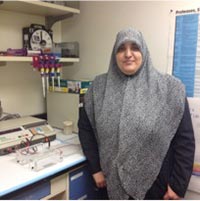
Name: Samiha Benrabaa
Education: M.S. at Qariuens University in Libya, currently working on Ph.D. at CSU.
Hometown: Benjhzi, Libya
Career Goal: A long-term goal of Samiha’s is to earn her Ph.D. in America and then travel back to Libya and become a professor at her home university.
Favorite Memory: Samiha’s most significant experience from the lab is spending two semesters gathering data for one gene sequence–about 1500 nucleotides worth of data. Then, after unexpectedly finding a gap in the sequence, having to spend two more months acquiring the last seven nucleotides. “This was a surprising amount of work and time to spend gathering such a small amount of data” Samiha says. However, she still values the experience because it is representative of the often slow and tedious process of gathering relevant data in the lab.
Project: Characterize, identify, and quantify Halloween genes in the Y-organ of the blackback land crab (Gecarcinus lateralis).
Trick or Treat?
Samiha is working to uncover the mystery of a group of genes called Halloween genes. Halloween genes are involved in very specific mechanisms in the cell that activate key enzymes in the molting cycle. Little is known about how these mechanisms work. Samiha is investigating the process by examining sequences of DNA expressed by the Y-organ (the growth regulator in the crab) at different stages of the molting cycle. Y-organ samples, showing gene expression patterns, are extracted from crabs at various stages of the cycle and then compared to each other. The hypothesis is that different types and amounts of genes will be expressed at different stages.
Solving the Mystery
The genes being examined are directly involved in the production of ecdysteroids, which are the main hormonal regulators of the molting cycle. Examining the expression of Halloween genes should provide insight to the specific regulations of the molting cycle. This insight does not only behoove Dr. Mykles’ researchers as they delve into the mechanisms of molting, but provides a whole new perspective of the cellular mechanisms of the crab.
Building Up the Basis of Knowledge
The cellular process of molting may seem exclusively relevant to the Crab Lab’s research. However, the knowledge of even one cellular process can carry over and assist in understanding a multitude of processes. In science, the understanding of something small can serve as a building block for much bigger concepts. The scientific community is a collaborative web that is continually growing in breadth and connectedness. The research being done in this lab is just a small strand of the web, and will aid in a broader understanding of the natural world.
Primary Investigator
Undergraduate
Graduate
Ph.D.
- Astrid Wittmann
- Natalie Pitts
- Kathy Cosenza
- Samiha Benrabaa
- Alejandro Lopez-Ceron
- Nada Rifai
- Sunetra Das
